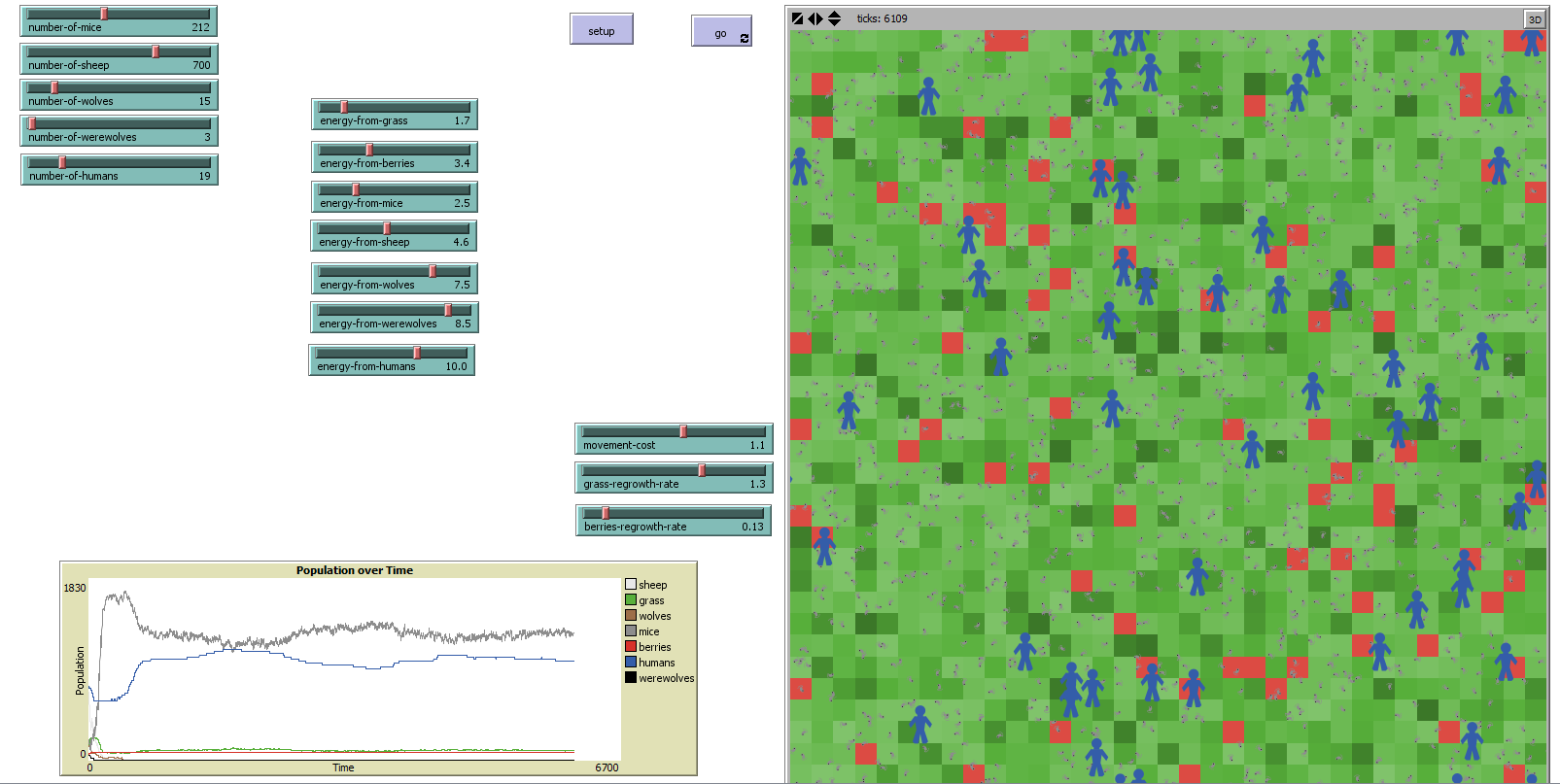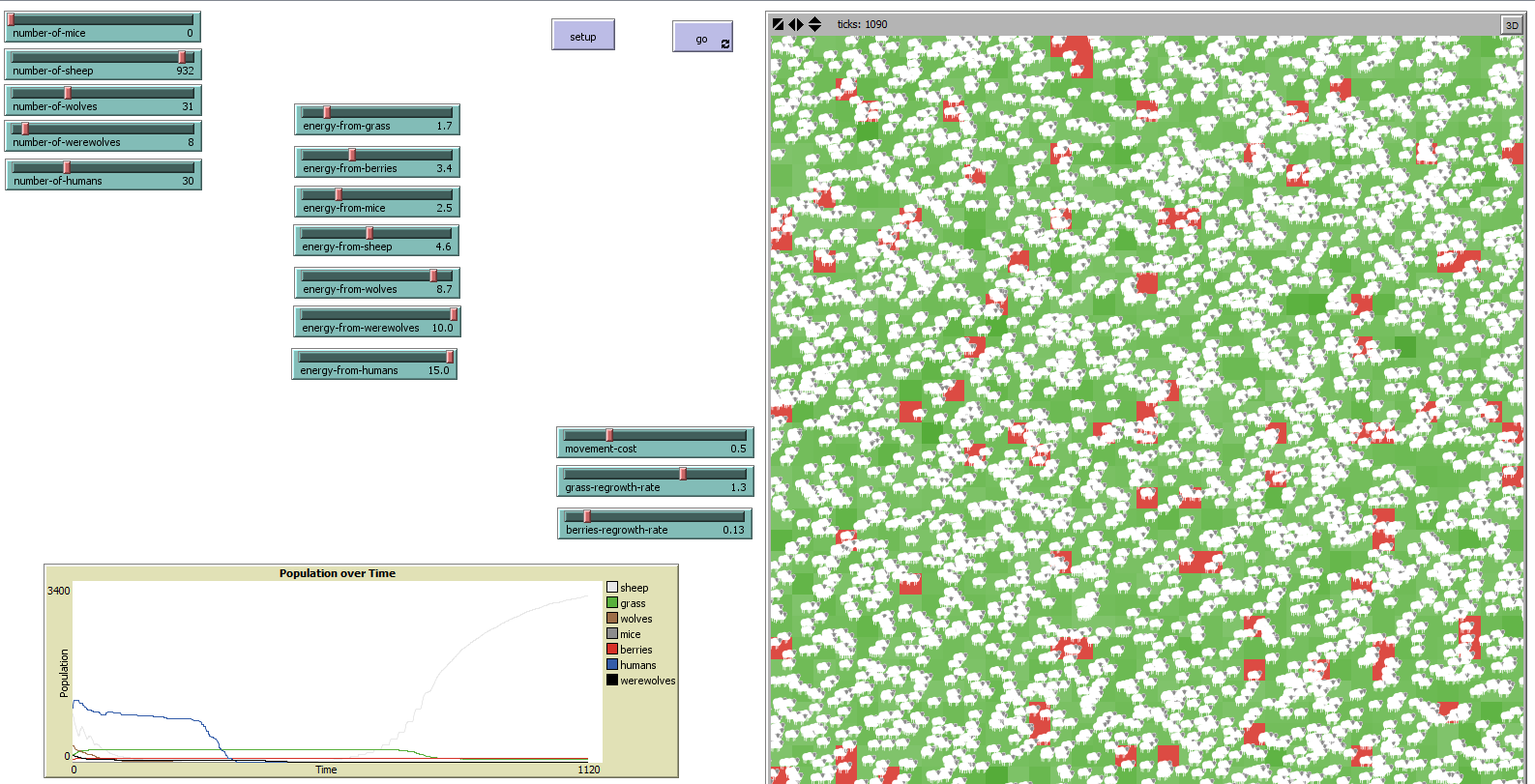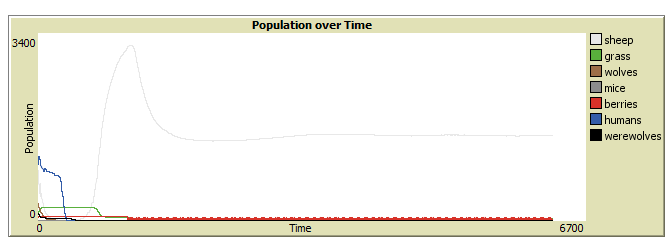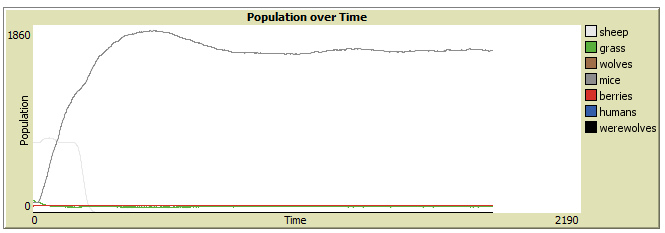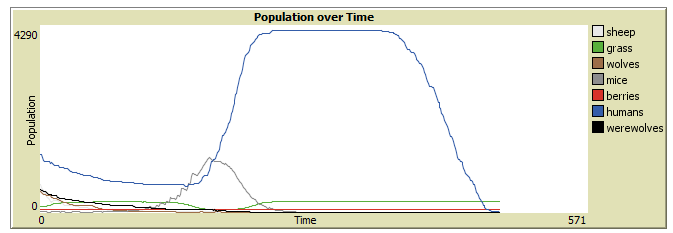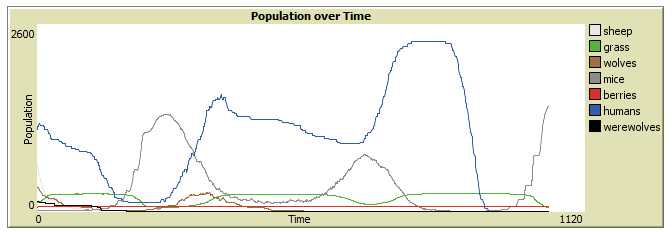Difference between revisions of "Predators & Prey"
(→Wolves) |
|||
| Line 119: | Line 119: | ||
==Code== | ==Code== | ||
[[File:Esterka sim wolf-sheep.nlogo]] | [[File:Esterka sim wolf-sheep.nlogo]] | ||
| + | |||
| + | ==Paper== | ||
| + | [[File:Esterka sim xestj00.pdf]] | ||
==Sources== | ==Sources== | ||
Latest revision as of 16:31, 16 January 2017
Contents
Introduction
Wolf and sheep is a classic population simulation and my model builds up on that. We have several different turtles on the landscape. Of course we have wolves a sheep. Than mice, humans and werewolves. Plus patches can have either grass or grass and berries.
In this simulation we can explore much more complex population relationships and population curves.
Method
Software
NetLogo 5.3.1 (February 29, 2016)
Simulation Details
In simulation we build up on wolves & sheep population models. We have several prey and predators wondering around. In our simulation some turtles can be prey and predator at the same time. This means that every time two predators meet up, they have to fight with each other. And if a predator cannot defend himself he becomes pray. This is determined by chance and turtle's attack strength.
Two prey we have in a simulation are mice and sheep. They only eat grass or berries which grow on patches. Mice are much more fast and can breed really fast so their population can get out of hand very quickly. Sheep are much bigger - they provide more energy - but also slower and breeding is more difficult.
All turtles have: Energy - is consumed when moving around and is replenished by eating, if it hits 0 the turtle will die Attack - this is the attack force modifier for the turtle; bigger it is the bigger the chance for turtle to win the fight Speed - bigger the speed, more patches can be crossed in one move Movement modifier - this is used to decrease the movement cost for some breeds
Patches can grow grass or some patches (determined by random chance) can grow berries which provide more energy.
Simulation is based on model from Introduction to Agent-Based Modeling (2015) from Wilensky and Rand.
Model
Grass
Grass grows on every patch and provides energy for herbivore or omnivorous turtles. Regrowth rate is one of the user inputs.
Berries
Berries are grown on some patches and provide energy for every herbivore or omnivorous turtle. In default they provide more energy than grass. Regrowth rate is one of the user inputs.
Mice
Mice are herbivore, small, they can breed easily and are fast. They also provide small amount of energy. Starting number and energy gained from eating them are user inputs.
Sheep
Sheep are a bigger herbivore that can eat grass or berries. They provide more energy. Starting number and energy gained from eating them are user inputs.
Wolves
Wolves are a classic predator that can eat mice, sheep or humans. Starting number and energy gained from eating them are user inputs.
Humans
Humans can dominate all turtles. They are only omnivorous turtles so they can eat mice, sheep, werewolves, wolves and also berries. Starting number and energy gained from eating them are user inputs.
Werewolves
These are a special kind of a turtle. They are strong but their breeding is much more complex. They have to "infect" other turtle that dies and werewolf is born. These turtles are in the model for much more complex population behavior. They can eat mice, sheep, wolves and humans. Starting number and energy gained from eating them are user inputs.
One other user input is movement cost for all turtles.
Results
Case 1: Balance
In this case we try to simulate real world scenario. Goal is to find a dynamic equilibrium and find out which turtles are going to be left.
As we can see with these realistic settings we can reach a dynamic balance between mice and humans. Mice can no longer reproduce more because they have no more grass and berries and if human numbers go up mice go down and humans start to decline as well.
Case 2: Sheep domination
Now we turn off mice and set movement cost to much lower number. This means sheep can reproduce much more easily.
We did not find the balance in the ecosystem between the prey and predators. Sheep managed to survive because the predator numbers were to small and without mice they had much less food then in the first case. This meant that sheep population skyrocketed (to about 3000 sheep) and then found balanced (around 1500 sheep) between population and grass/berries.
Case 3: Prey infestation
In this case we turn on only mice and sheep to find out if the mice will dominate - as is expected.
And hypothesis is confirmed - since mice need lot less energy to produce then sheep they quickly gain numbers and start to eat a lot of grass and berries. This makes sheep extinct and mice find balance.
Case 4: Humans
In the last case we give humans small advantage in starting numbers. Plan is for them to dominate the landscape. But usually they kill all other predators and then just sheep or mice (depending who wins for the herbivores) and humans are left. Then human population gets out of control and since they eat all sheep/mice they die out because berries are not enough food.
In some tries we can see little bit of a balance but still either humans eat all of the prey or the prey survives and then dominate.
Conclusion
This simulation provides much more detailed look into Predators & Prey problem. Because there is a lot more variables it is harder to find dynamic equilibrium. But if this balance is found it is usually between one predator and one prey. I think that this fact is the most interesting thing that came out of my simulation.
Also it is quite fun to play with different inputs and in the future I would like to make the system even more complex and put all of the variables into user inputs (speeds, attacks, random seeds etc.)
Code
File:Esterka sim wolf-sheep.nlogo
Paper
Sources
http://ccl.northwestern.edu/netlogo/docs/dictionary.html
